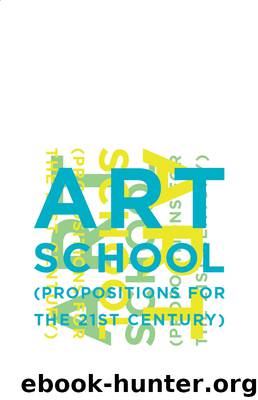Art School by Steven Henry Madoff

Author:Steven Henry Madoff
Language: eng
Format: epub
Publisher: The MIT Press
Published: 2009-06-20T04:00:00+00:00
If the development of art making in Latin America was a product of colonialism, so was the development of the corresponding educational systems. In both areas there were flashes of resistance, but the dictum of hegemonic cultures tended to overwhelm them.
In art the problems became clear very quickly: if the art was old, autochthonous, and precolonial, it was segregated and declassed as archeology; if it was contemporary, it was considered folklore. Initially, during Spanish and Portuguese colonization up to the early to mid-nineteenth century, depending on the area, the better craftsmen were hired by the colonizers to produce art for them. It was mostly intended for churches, a rather sordid cultural castration that today is highly admired under the positively twisted term colonial art. At its best, colonial art was compromised, fusing colonially imposed imagery with local imagery, such as Christian saints vested with native deities. Today this colonial situation hasn’t changed much. Craftsmen in art are not generally hired anymore, and they don’t work for churches but for the art market and museums. Resistance to this is mostly expressed through searches for local “identity,” usually anticolonial in spirit, but the art remains largely overwhelmed by the legacy of contemporary hegemonic aesthetic colonialism. Emphasis is on content, and because of this it tends to create visual pollution with programmatic kitsch. At its worst, the more radical fight against hegemony is through either endorsing other hegemonies (as was the case with applications of Social Realism) or local conventions that confirm an idealized past and arrive dead on arrival on the canvas. At its best, the fight ignores “art” as a goal and lets itself happen as a natural wrapper for ways of thinking and acting, usually also with a political bent. The definition of what comprises art and what does not has nevertheless remained relatively coupled to the old colonialist definition. Accordingly, art is whatever the centers decide. During early colonialism, this meant an emphasis on skills and representation using the two main media: painting and sculpture. Later it would be the whole sequence of aesthetics guided by an imported chain of isms. And the same happens with art education.
The push for resistance in education at large in Latin America has been more effective than in art education, although in the long run it lost its compass thanks to a spread of dictatorships over the continent that became particularly acute during the 1960s. The first formidable move to have universities seriously and radically address local needs took place in Córdoba, Argentina, as early as in 1918.1 It was a cataclysmic event for the ruling classes and is known as the University Reform of Córdoba. It was achieved through a violent revolution led by the students. The reform, on the heels of the Russian Revolution the preceding year (and as a consequence of it), set down several crucial concepts: education was to be a civil right; the university was conceived as an autonomous state within the state, even when funded by the
Download
This site does not store any files on its server. We only index and link to content provided by other sites. Please contact the content providers to delete copyright contents if any and email us, we'll remove relevant links or contents immediately.
The Art of Boudoir Photography: How to Create Stunning Photographs of Women by Christa Meola(18537)
Red Sparrow by Jason Matthews(5390)
Harry Potter 02 & The Chamber Of Secrets (Illustrated) by J.K. Rowling(3620)
In a Sunburned Country by Bill Bryson(3481)
Drawing Cutting Edge Anatomy by Christopher Hart(3454)
Figure Drawing for Artists by Steve Huston(3381)
Harry Potter and the Prisoner of Azkaban (Book 3) by J. K. Rowling(3304)
The Daily Stoic by Holiday Ryan & Hanselman Stephen(3230)
Japanese Design by Patricia J. Graham(3109)
The Roots of Romanticism (Second Edition) by Berlin Isaiah Hardy Henry Gray John(2878)
Make Comics Like the Pros by Greg Pak(2852)
Stacked Decks by The Rotenberg Collection(2811)
Draw-A-Saurus by James Silvani(2655)
Harry Potter and the Deathly Hallows (7) by J.K. Rowling(2640)
Tattoo Art by Doralba Picerno(2600)
On Photography by Susan Sontag(2575)
Churchill by Paul Johnson(2506)
The Daily Stoic by Ryan Holiday & Stephen Hanselman(2458)
Drawing and Painting Birds by Tim Wootton(2438)
